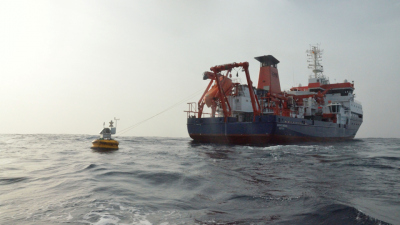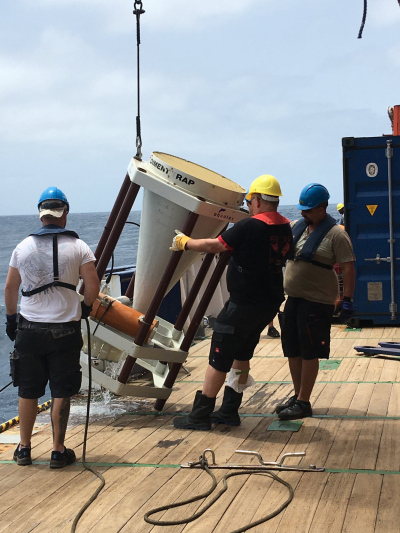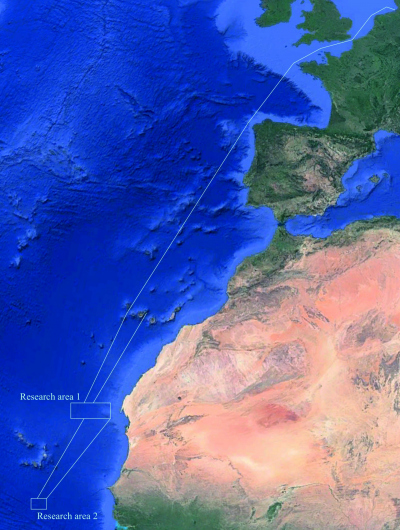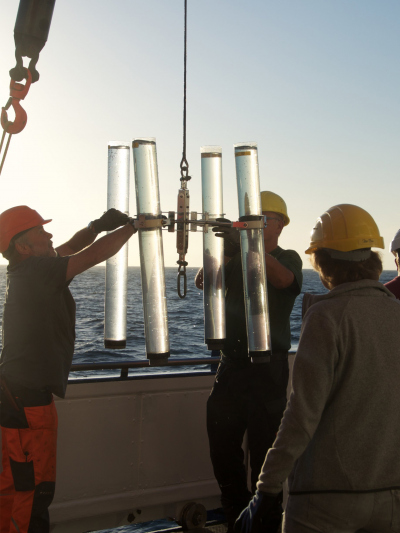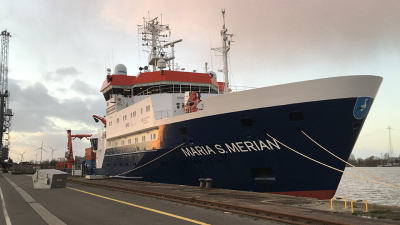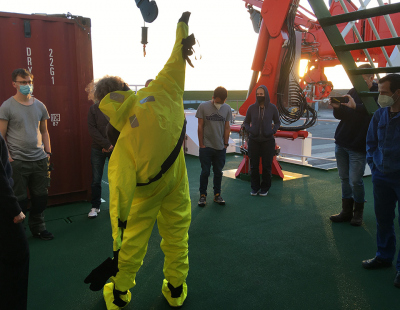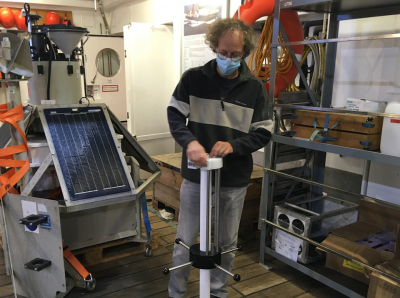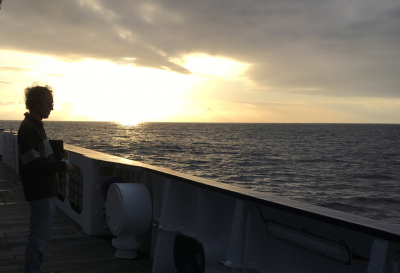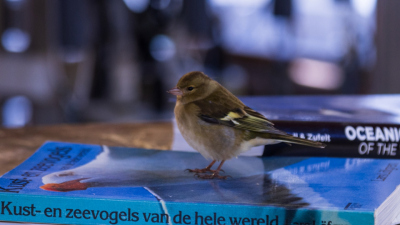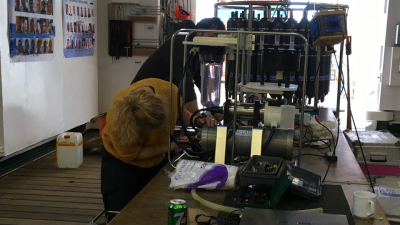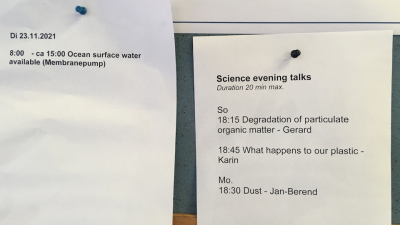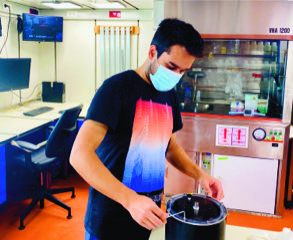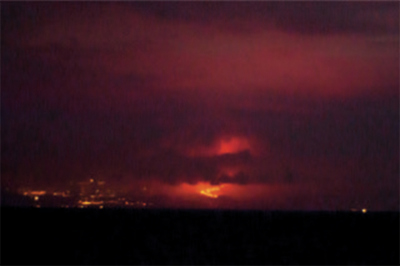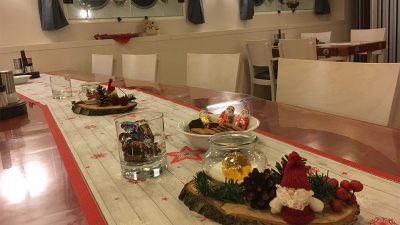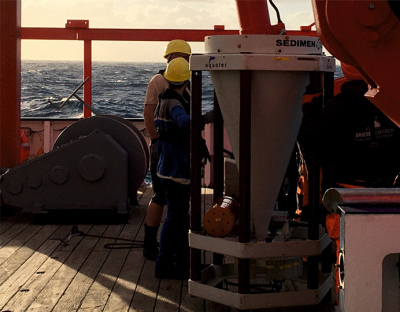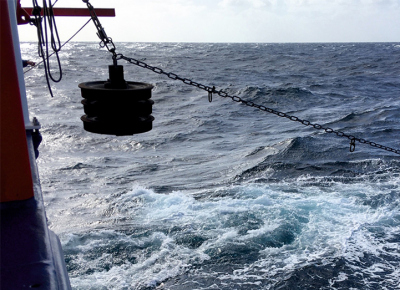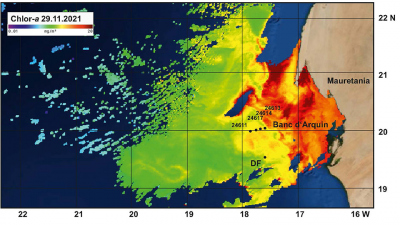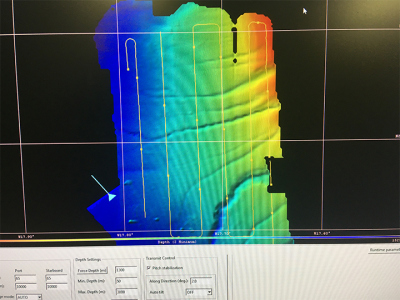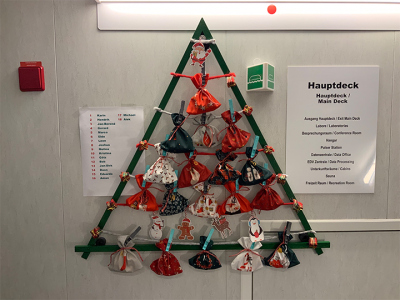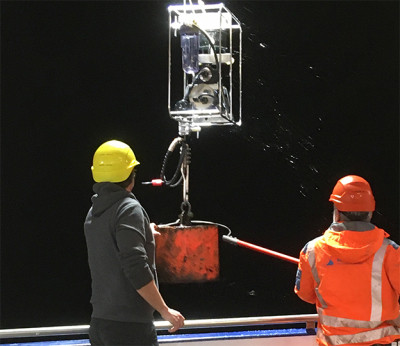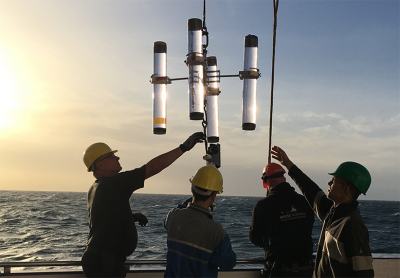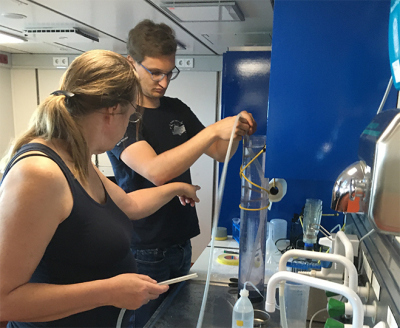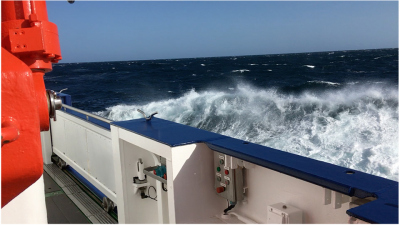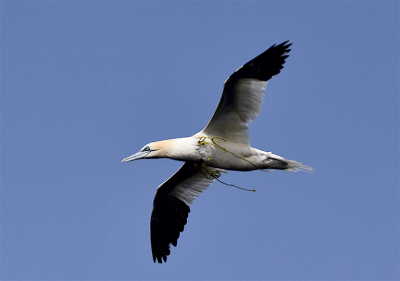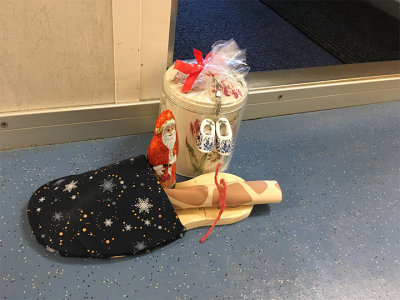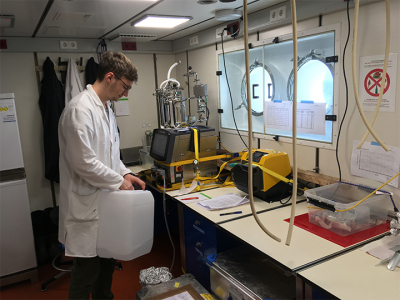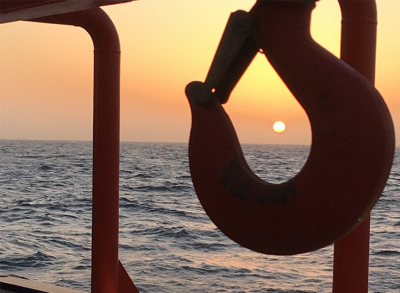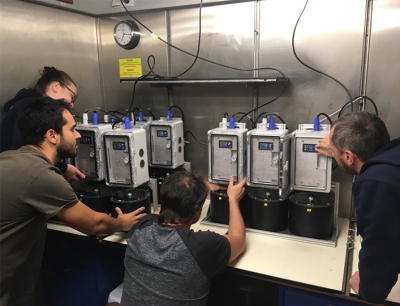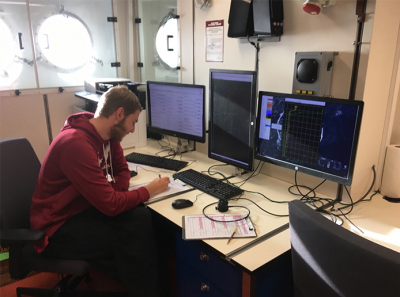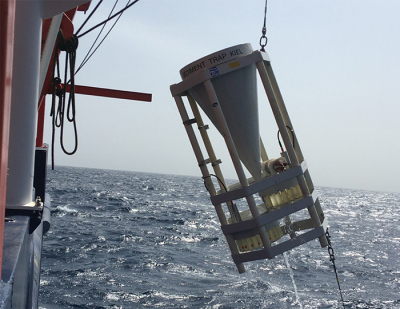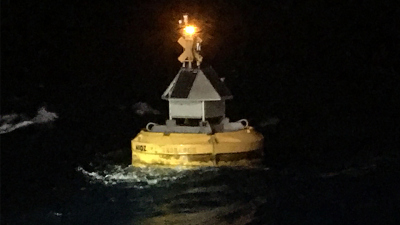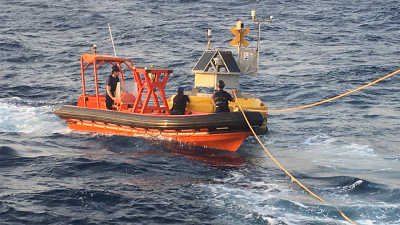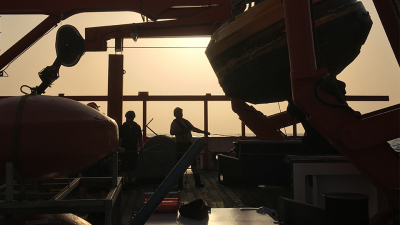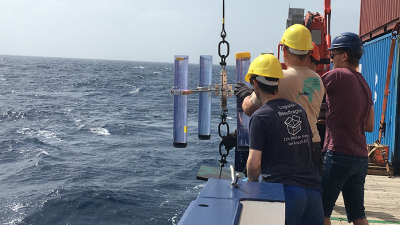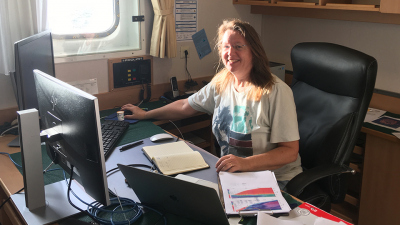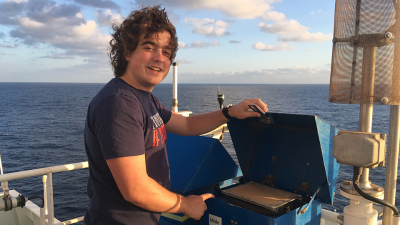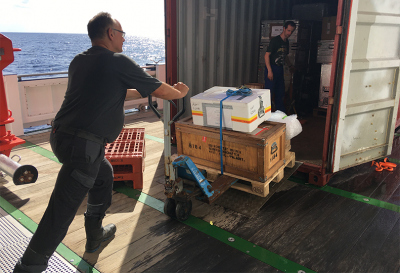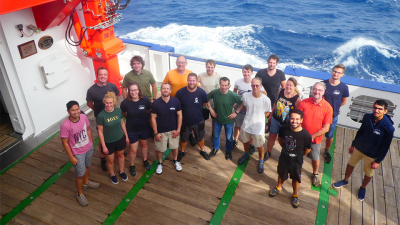- Home
- Discover
- Ship's logs
- Logbuch MSM 104/1
Logbuch MSM 104/1
The research cruise M104/1 (GPF 20-1-69) will take place from November 18 to December 15, 2021, and will travel off the west coast of Africa, to the upwelling area at Cap Blanc.
During the cruise, research activities on the project "SIPA" ("Sinking particles, their production, transfer and transformation") will be carried out. The cruise is led by Prof. Karin Zonneveld from MARUM - Center for Marine Environmental Sciences of the University of Bremen within the RECEIVER Unit of the Cluster of Excellence "The ocean floor - uncharted interface of the Earth".
On board the research vessel MARIA S. MERIAN are a total of 18 researchers from MARUM, the Department of Geosciences of the University of Bremen, the Alfred Wegener Institute (AWI), the Institute of Chemistry and Biology of the Sea (ICBM) and the Royal Netherlands Institute of Sea Research (NIOZ).
The upwelling area off Cap Blanc is one of the most productive regions in the world. It plays a key role in the global carbon cycle and thus has an impact on the world's climate. Plankton organisms absorb carbon dioxide, process it and sink towards the ocean floor after they die. In doing so, they move carbon from the atmosphere to the ocean floor (biological pump).
The researchers will work together to study the production of these particles, called sediment, their sinking in the water column to the sediment at the ocean floor, and changes that occur. They will sample the particle flux from the upper water column using free-floating traps. These traps float according to the prevailing water currents and collect particles at different water depths. At the same time, temperature, salinity, chlorophyll-a content and turbidity of the water column are recorded throughout the investigations.
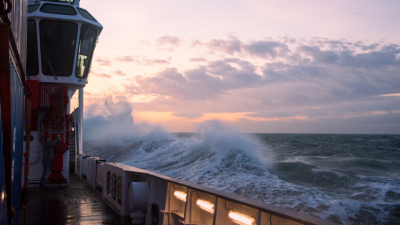
Current position of the RV MARIA S. MERIAN
More information about the MSM 104 voyage
Latest News release about the start of the voyage
Here Karin Zonneveld reports in a logbook about life and work on board.
Wednesday, November 17: Finally back at sea!
There she is, the research vessel Maria S. Marian, in the port of Emden. She will be our home for the next four weeks.
This morning we, 14 scientist of the MARUM and 4 scientists of the Royal Netherlands Institute of Sea Research left Bremen to embark the R.V. Maria S. Merian. To minimise the risk of a Corona infection we are all fully vaccinated and negatively PCR-tested.
We arrived at lunchtime where we were welcomed by Captain and crew and :-) an excellent meal.
After Lunch, the quietness of the harbor was used to unpack and build up as much as possible laboratory and sampling equipment to store them wave and weather proof before departing. We furthermore absolved a safety briefing where we learned how to wear a survival suit.
Now in the early evening, everything is sealed and ready for departure tomorrow morning.
We look forward to start our transit south, to the upwelling area off Cape Blanc (NW Africa)
Weather: variable cloudiness, occasional showers, no wind
Friday, November 19: "Flight" through the English Channel
Today we "fly" though the English Channel with the tide and wind from the back. We are happy to have left the North Sea with its short waves that hit us in unregularly pace from the site.
Life today is characterized by preparation. Beside scientific and technical briefings we use the quit sea to build up and test our equipment for the first sampling station. Due to Corona and Brexit some spare parts, new sensors and equipment arrived at the MARUM weeks to months later than was initially planned. Although they arrived in time for a quick check on functionality there was no time to get a routine for their deployment and optimize their functionality for our special scientific purposes.
Weather: cloudy but dry, Wind speed 5, Speed of Vessel 14 kn.
Sunday, November 21: Animal travel companion
The Bay of Biscay shows itself from its best side. We sneak south in between two low pressure fields. The results a calm bleu ocean where so now and then a plume of water is pushed into the air and a big tail fin becomes shortly visible .....the indication that whales are fishing along the shelf edge. A check in one of the books that lay out in the hangar reveals that the form of the water plume and form of the tail are typical for a right whale. Today we also spotted the first dolphins that tried to keep up with the MARIA S. MERIAN.
Since yesterday we also have some hitchhikers on board, a few finches and a robin. They are curiously hipping around in the hangar and watch us preparing and testing our equipment.
Weather: sun and clouds dry, Wind speed 5, Speed of Vessel 12 kn.
Monday, November 22: Introduction to the work of others
We are about halfway our transit and soon reach international waters where we will take in some sea water that will allows us a detailed testing of equipment and sensors to be optimally prepared the first sampling station.
The day is therefore filled with testing our equipment to be sure that the transportation to the ship did not cause any damage and the equipment functions perfectly.
In the evenings, we enjoy the "science evening talks" where one member of each participating group gives an introduction lecture about their research field, the state of the art in the research area as well as what their group is going to investigate/sample and why this is important.
Weather: sun and clouds, Wind speed 7 Bft, Speed of Vessel 11 kn.
Tuesday, November 23: How do aggregates form?
Contribution by Eduardo Queirez Alves
Yesterday we started testing the equipment for an aggregate formation experiment. Aggregates are clumped particles that sink to the ocean floor. In the ocean, they can consist of clumped unicellular algae, for example. We suspect that organic substances dissolved in the water can also react with each other to form particles and aggregates. But we do not know exactly how they form.
In the so-called Couette tanks, we simulate the shear forces that prevail in the ocean. Theoretically, these should promote the formation of particle aggregates from dissolved organic matter. Over the next three days, we will conduct the experiment with ultra-pure water to determine the background levels and test the motors responsible for the rotational motion. This way we can ensure that everything is ready for our actual measurements with seawater when we reach our first station.
Weather: cloudy, Wind speed 7 Bft, Speed of Vessel 11 kn.
Thursday, November 25: A unique natural spectacle
5:30 in the morning, on the bridge of the MARIA S. MERIAN the passengers appear one after the other. A red glow appears on the horizon... there must be the island of La Palma.
As we approach the island, the glow becomes more intense and soon a glowing lava flow can be seen winding its way down the mountainside. Soon, with a binocular, you can also see individual branches of the flow and occasionally an eruption higher up the slope. The volcano is very active. A fantastic spectacle in the dark night, a unique experience.
Weather: cloudy, Wind speed 7 Bft, Speed of Vessel 11 kn.
Sunday, November 28: First Advent in the Atlantic Ocean
First Advent.
This morning we were welcomed in a beautifully decorated breakfast table that contained many small sweets.
Breakfast contained apart from fresh fruits and freshly baked bread, soft or hard-boiled eggs and/or pancakes with apple compote. Thank you, sweet ships galley team, and stewardess for this very nice surprise.
Weather: Partly cloudy, wind force 7 Bft. Position: 21°13' N, 20°52' W
Monday, November 29: Tracking "Carbon Rain" with Sediment Traps
Today we finish our research activities at this position. After being serviced, our moored sediment traps were returned to the ocean.
These traps consist of big funnels that are connected to a wire. At the upper end of the wire propellant balls take care that the funnels stay in the upright position in the water column. At the other end of the wire an anchor, consisting of three railway train wheels, is connected with a so called "releaser" to the wire. This anchor causes the mooring to stay under water on a fixed position at the ocean floor.
The "releaser" steers a connecting hook. When we send down a unique sonic signal, it reacts by releasing this hook such that the propellant balls bring the wire with the funnels and releaser back to the ocean surface.
The funnels itself end up in small buckets. A computer steered carrousel causes the buckets to be replaced every two weeks. All particles that rain down through the ocean that fall in the funnel end up in these buckets.
A large part of these particles consist of plankton remains that contain carbon. This carbon has been taken up by this plankton in the upper water column where it has previously been defused from the atmosphere into the ocean. The particle rain lowers the atmospheric CO2 concentration of the atmosphere by transporting carbon to the ocean floor where it cis naturally been stored for thousands of years.
The MARUM monitors this "Carbon Rain" with help of the sediment trap program already since 1988 and becomes on this way information to what extent global climate change influences these storages of carbon in the ocean.
We will now pick up our drifting trap that floats a few miles north of our current position to sail east to continue our research near the coast of Mauretania.
Weather: Partly cloudy, wind force 8 Bft, position: 21°13'N, 20°52'W
Tuesday, November 30: Between upwelling filament and deep-sea canyons
On this windy beautiful day, we arrived in our second research area in Mauretania coastal waters in front of the Banc d'Aquin.
Satellite images show that there is active upwelling of deep water towards the surface ocean along the rim of the shelf. This results in high plankton production in the surface waters.
After releasing a drifting trap in such a "upwelling filament" we sailed to the coast to map the geography of the ocean floor. The ocean floor here is full of canyons.
These canyons were formed during ice ages when the sea level was about 126 m lower than today. When the ice ages ended and the ice caps of the antarctic and arctic melted, sea level rose and the ocean flooded the Banc d'Aquin and the canyons. Since we do not want to lose our equipment in one of those underwater canyons, we mapped the ocean floor to look for the best "safe" places to deploy our equipment.
Weather: Without clouds but Sahara Dust, Wind force 9 Bft.; Position: 20°01' N, 17°39' W
Wednesday, December 01: Pre-Christmas season at 19 °C
Today again a very nice surprise welcomed us in the corridors of the ship. Although it is 19 °C outside and it doesn't feel like winter, Christmas time is approaching :-) Thanks again sweet MARIA S. MERIAN Crew.
Weather: Cloudless, Sahara dust, wind force 5 Bft., Position: 20°01' N, 17°39' W
Thursday, December 02: Night shift
During a research cruise like this, scientific activities are being executed both day and night.
This night, the ocean waters were sampled with so called "In-situ Pumps". These pumps can be described as "underwater vacuum cleaners". It pumps underwater water through a filter.
The pumps are being attached to a wire that at its outer end contains a weight of 300kg. We let the pump go down to a water depth just above the ocean floor. Just above the ocean floor the water column contains a lot of particles.
We want to know what these particles are (for instance algal remains, Sahara dust or microplastics), where they come from, how long they already float in the ocean and what their molecular composition is. Therefore, we "harvest" the filters and store them at -20°C to analyze them in the laboratories back in Bremen, Bremerhaven and Oldenburg.
During the deployment of the pumps a lot of little terns flew next to the ship to catch little fish that were attracted to the light beam of the ship on the ocean.
Weather: Cloudy and Sahara dust, wind force 7 Bft, position 19°59' N, 17°43' W
Friday, December 03: Floating traps
Since a few days a working rhythm has developed. After the end of the night program which we execute on stations along an upwelling cell - open ocean transect, we head south to the position of our floating trap. This trap sends us its position with a small iridium transmitter.
In the morning, we start with recovering the floating trap, harvest the samples and deploy it again. The trap contains three times four tubes filled with water with a higher salt concentration than sea water. This causes the water to stay inside the tubes. All particles that rain down through the water column become trapped in the tubes. Traps collect particles at 100m, 200m and 400m depth.
We deploy the traps at the rim of an upwelling cell that now slowly changes its characteristics to become an offshore drifting filament of upwelled water. By deploying the trap several days after each other we can follow the change in particle rain in detail.
The fresh upwelled water contains many nutrients that become slowly depleted when the waters float offshore in form of a filament. With two sensors that register temperature/salinity/oxygen and Chlorophyll-a/turbidity connected under the 100m tubes, we can follow how the characteristics of the water masses change during this transition.
After collecting the samples, they are immediately processed in the laboratory at the ship to ensure detailed analyses back in Bremen.
After deployment of the drifting trap we head north, back to our transect to continue station work there. Today with a blue sky and wind speed 8 Bft. The ocean is really spectacular.
Weather: sunny, no dust, wind force 8 Bft.; position 19°38' N, 17°38' W
Sunday, December 05: Microplastics and sediment archives
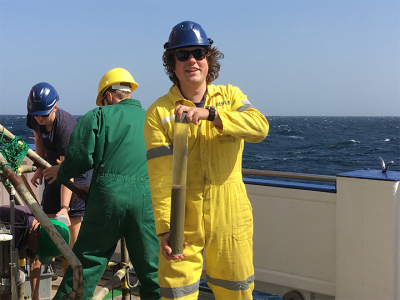
Finally, the weather turned to show her nice site and the wind strength reduced.
Today we collected sediment archives from two locations along the upwelling - open ocean transect with a multicoring device. When particles "rain" from the surface ocean to the ocean floor, they settle there and can become preserved. Over time more and more particles settle on to of each other with the oldest ones on the bottom and youngest ones at the top. Since the particle rain composition is depending on the export production in surface waters, it changes in composition when conditions in surface waters change. By investigating the particles in a sediment archive we can reconstruct past oceanic conditions.
Apart natural produced particles such as phyto- and zooplankton remains also micro-plastic rains down and gets preserved on the ocean floor. Unfortunately, the nearby Banc d'Arquin is one of the highly with plastic polluted coastal regions of the world. It is therefore likely that sediments at the shelf edge functions as "garbage bin" for micro plastics. With special at the MARUM constructed stainless stainless-steel multicore tubes we collect sediment archives to investigate how and to what rate micro plastic is stored in ocean floor sediments to obtain insight into the pollution problem future generations have to face.
We use stainless steel cores to avoid micro plastic contamination during sampling. furthermore, we avoid the wearing of plastic derived clothing (e.g. fleece jackets) during sampling, minimizing the air-exposure during harvesting of samples and use stainless steel filters and sieves.
Weather: sunny, new Sahara dust, wind force 6 Bft., position: 19°38' N, 17°38' W
Monday, December 06: Between stations
This beautiful sunny morning started with again a nice surprise. Sint Nicolaas has found its way to the MARIA S. MERIAN. Many thanks to Crew, Dutch and German Sinterklaas.
This morning we finished working off the Mauretanian coast to head south to the position of a second dust buoy of the Royal Netherlands Institute of Sea Research. We use the time to process and analyze the many samples we collected.
Aman and Alek concentrate Sea water from different water depths to investigate which sugar molecules that being produced by plankton. The furthermore investigate which sugar molecules are being degraded and which survive transport through the water column to be preserved in a sedimentary archive
Weather: sunny, new Sahara dust, wind force 5 Bft.; Position: 18°53' N, 17°59' W
Tuesday, December 07: Experiments on aggregate formation
We are on a transit south to a station south of the Cap Verde Islands. The weather is really nice and the tropical temperatures (water temperature 27°C) provide us beautiful "summer" evenings.
During the transit, we execute aggregate forming experiments with water we collected in the active upwelling. Water upwelled to the surface contains a lot of nutrients which can be used of plankton to grow. Apart from nutrients they uptake carbon out of the water column which previously diffused
in the form of CO2 from the atmosphere into the ocean water. However, when the plankton dies or is being eaten it is been decomposed by microorganism and the carbon molecules are released again to the ocean water as so called "dissolved organic carbon" (DOM) and as such does not contribute the "ocean carbon rain". We have however, strong indications that this DOM might clump together when being stirred to form new larger particles that than in turn sink to the ocean floor.
In a "rolling tank" experiment Malina and Michael (MARM Receiver-Univ. Oldenburg) investigate the particle formation out of DOM. Hendrik (MARUM Receiver-AWI) will investigate the age of the carbon in dissolved and particle form.
Weather: sunny, new Sahara dust, wind force 5 Bft., position: approx. 15°00' N, 19°00' W
Wednesday, December 08: Work at 5040 meters depth
Today we arrived in the area where our colleges of the Royal Dutch Institute of Sea Research will service a sediment trap and a dust collecting buoy.
We started the day with measuring the water column characteristics with a "CTD". This device contains sensors that measure temperature, conductivity, oxygen concentration, chlorophyll-a concentration and turbidity. With an electrical connection within the wire it sends this information "real time" to a computer on the ship. This evening we deploy the CTD to a water depth of 5040 m.
After we characterized the water column and released our drifting trap, we head of to position of the Sediment trap mooring of the NIOZ. We released it from its anchor at 5066m depth and recovered it successively.
Weather: sunny, Sahara dust, winds 5 Bft., position: approx. 11°28.919' N, 22°42.894' W
Thursday, December 09: Buoy recovery
On this beautiful morning, our first activities are the recovery of the Dust Buoy of the Royal Netherlands Institute of Sea Research. This Buoy has collected the amount of Sahara Dust over the last year.
The Buoy is anchored at 5120 m depth and is allowed to drift around its anchor point for about one Nautic Mile. It sends its exact location twice a day with an iridium transmitter.
During the night hours, we sailed to the last known position. The buoy has a strong flash light which makes it most easy to detect it during the dark hours.
To recover the Buoy at first two wires are being connected to the buoy. Than it is moved slowly to its anchor point. This, to lose the wire with which it is connected. When the anchor point is reached, the buoy can be hived on Deck to be able to service it and recover the collected samples.
Weather: sunny, Sahara dust, wind force 5 Bft, position: ca. 11°21.511' N, 22°59.003' W
Friday, December 10 : Final sampling
Today we reached the last station where we were able to collect samples before heading north again where we plan to enter the port of Las Palmas on the Canary Islands at the 15th of December.
Our last deck activities were to redeploy the NIOZ sediment trap mooring that is now programmed to collect samples until January 2023 followed the collection of our drifting trap that had been released to float in the surface currents two days ago.
In 2023 MARUM participants will be back at this location with the Dutch vessel RV Pelagia. The MARUM and NIOZ have a long-term collaboration and in the past the NIOZ team have been joined several GeoB and MARUM expeditions to service their traps and dust buoys in this region. Next year the German team will join the RV. Pelagia to service the MARUM sediment traps. With this international cooperation, we optimal use our common marine expedition resources.
Weather: Sunny, Sahara dust, wind force 5 Bft., position: ca. 16°17.72' N, 22°1721' W
Saturday, December 11: Transit to Las Palmas
From now on we are on transit to Las Palmas. Although we had our last station yesterday, o9ur scientific activities have not ended yet. In the laboratories, the last samples are being treated such that they can be transported on a safe, contaminant free way to allow further high precision analyses in our laboratories at home.
First results of the aggregate forming experiment where the forming of particulate organic matter out of dissolved organic matter is investigated are very promising. Small aggregates have been formed in the roller tanks. These are now carefully being "harvested" to be able to study their composition and age at the MARUM (Bremen), the university of Oldenburg and at the AWI (Bremerhaven).
Weather: Sunny, Sahara dust, wind force 5 Bft., position: ca. 16°17.72' N, 22°1721' W
Monday, December 13: The chief scientist
Today the ocean shows itself again from a friendlier side. Yesterday strong winds and waves caused that the Deck was "washed" in regular time distances.
Today everybody (except for me the principal scientist) is very busy with finishing the experiments, processing and analyzing the last samples and packing of all the equipment that is not used anymore into the boxes to be brought home in oversea containers.
My task is now to write al the cruise protocols and ship reports. Furthermore, I take care that before we leave the ship in two days, maps and lists of the cruise track and sampling stations as well as collected data will be available for all cruise participants and scientist onshore that will later work on the material and data.
.... well actually my own task was always somewhat different to the rest of the team.
As chief scientist, I am responsible for the planning.
In praxis that means that three days in advance, the exact location of the next stations are planned by taking into account the current weather (is the weather forecast such that large equipment such as the buoys/sediment traps can be serviced), the local oceanic conditions (e.g. where are upwelling cells developing to deploy drifting traps), how does the ocean floor look like (are there canyons or other disturbances on the ocean floor) what is the distance between the preferred stations and how much time does the ship need to reach the different stations.
Obviously, I have to take into account as well, which samples and data should be collected at the stations to provide the cruise participants here at the ship and the PhD's, PostDocs and other scientist at home all high-quality samples and data they want and how long does it take to deploy the individual devices and collecting of data. Then the planning is presented to the captain and preparations are made for the execution.
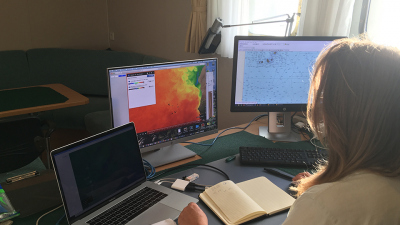
The nautical team on the bridge ensures that the ship arrives at the station and remains as calm as possible during sampling, while the deck crew, machinists, electricians and technical staff ensure that the equipment can be used safely and without problems or damage.
Weather: Sunny, no dust :-), wind force 4 Bft., position: approx. 24°14.30' N, 21°14.98' W
Tuesday, December 14: Last work with the dust-vacuum-cleaners
Our last sailing day has started.
Yesterday evening we entered the national waters of Spain which caused that we had to stop or dust sampling program and the last sample of this cruise was collected. Our Dutch dust team from the NIOZ collected dust with two "dust-vacuum-cleaners" that were positioned on the top part of the ship. They investigate the size and mineral composition from the Sahara dust particles which they collected during the transit times. Their results will be compared to the MARUM investigations on the plankton production in the region as investigated with our drifting trap and in-situ pump projects.
Sahara dust contains a lot of minerals such as iron and manganese which are essential for plankton to grow. These minerals are not produced in the ocean itself and can only come into the ocean water by rivers or wind-blown dust. Sahara dust is therefore a major fertilizer for the ocean.
Weather: Sunny, wind force 4 Bft., position: ca. 26°40.366' N18°12.77' W
Wednesday, December 15: We say "Goodbye ".
Today we arrived in the morning in the harbor of Las Palmas. The final day at sea was characterized by packing, cleaning of the laboratories and cabins and storing our equipment in the containers.
Our great thanks go to the Logistik Team of the MARUM that supported this cruise. Götz and Marco took care for the safe transport of all our equipment, to and from the ship. Apart from the safe storage into the overseas containers with which our equipment and samples are being transported, this also involves a lot of paper work. Notably the exact description of the content of each container to be shipped for custom reasons requires a lot of very specialized secure documentation.
Now at the end of the cruise we are very happy with the large amount of high quality samples and data that we were able to collect. These samples and data form the basis of many Receiver and Recorder projects and we are curious to the outcome of the analyses that are waiting for the samples in our home laboratories.
The success of this cruise would not have been possible without the dedication and enthusiasm of the scientific team. Alek, Aman, Bob, Daan, Eduardo, Eldo, Gerard, Götz, Hendrik, Jan-Berend, Jan-Dirk, Joshua, Kristina, Leon, Marco, Melina, Michael thanks.
Our thanks also go to Captain Björn Maas and his crew for their great flexibility, excellent technical assistance, health service and by creating a very pleasant working atmosphere that substantially contributed to the success of this cruise.
We furthermore greatly appreciate the support and cooperation of the employees of the Gutachterpanels Forschungsschiffe (Deutsche Forschungsgemeinschaft), die German Research Fleet Control Centre (LDF) and Briese Research Schiffahrt that provided us the possibility to execute this research cruise MSM104 in Corona Pandemic times.
Weather: Sunny, 20°C., Position: Las Palmas harbor



